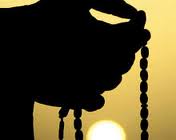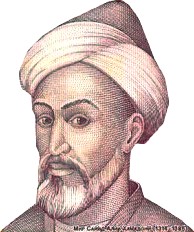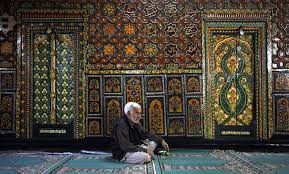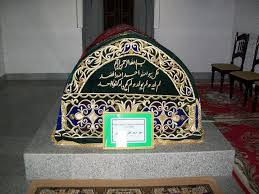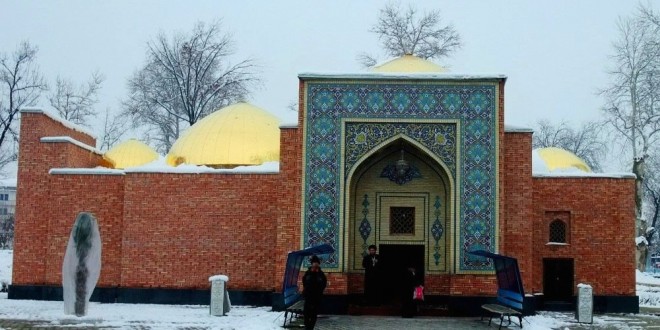The great Sufi master of Kubravi order Hazrat Amir-e-Kabir Mir Syed Ali Hamdani (d.786 AH), popular with his title Amir-e-Kabir, reviver of Islam in the Kashmir valley.
Hazrat Amir-e-Kabir Shah-e-Hamdan Mir Syed Ali Hamdani
Many saints came to the valley of Kashmir to preach and to propagate Islam, to name a few were: Bulbul Shah, Syed Jalal Uddin Bukhari, Syed Taj Uddin, Syed Hussain Samnani, and Yousuf. But the one who lit the torch of monotheism, in reality was Hazrat Amir-e-Kabir Sahah-e-Hamdan.
Parentage
His name was Ali, and titles were Amir-e-Kabir, Ali Sa'ani, and Mir. Besides them, the Chroniclers had mentioned several other titles:
Qutub-e-Zaman, Sheikh-e-Salikan-e-Jehan, Qutub-Ul-Aktab, Moih-Ul-Ambiya-o-Ul-Mursaleen, Afzal-Ul-Muhaq-e-qeen-o-Akmal-Ul-Mudaq-e-qeen, Al-Sheiyookh-Ul-Kamil, Akmal-Ul-Muhaqqiq-Ul-Hamadani etc.
He traced his patrimony through his father, Syed Shahab Uddin, to Imam Zain-ul-Abedein and finally to Hazrat Ali. His mother, Syeda Fatimah, with seventeen links, reached the Prophet.
His date of birth is disputed. To some it is 12, Rajab-Ul-Marjab 714 Hijri (12th October 1314) and to others is 12, Rajab 713 (12th October 1313). The former date appears more probable.
Education
Syed Hamdani came from an educated family. He was intelligent and quick of mind, and read the holy Qu'Oran, under the care of his maternal uncle, Hazrat Ala-Uddin and from him too he took his lessons on subjects outer and intrinsic for a period of thirteen years.
Spiritual Training
Hazrat Ala-Uddin, then, entrusted him to Sheikh Abul Bracket for Spiritual training, and after his demise he proceeded to Sheikh Mahmud Mizdiqani, a renowned saint of the time. The saint put him to severe tests and thus removed pride and haughtiness from him and inculcated in him virtues of humility.
Order
He belonged to the Kubraviya branch of the Suharawardy Order and received the role of the spiritual heir from Sheikh Abul Miamin Najam Uddin Muhammad-bin-Mohammad Azani.
Payers and Meditation
After studies, external and internal, in order to train his self; he went into seclusion and spent six years. He did not utter a single word relating
to material life. After the period, he again went to Hazrat Abul Barakat who attended to the cleansing of heart and physical exercise. He ordered him to go to Muhammad Mizdiqani. After the last rites of Hazrat Abul Barakat he presented himself to Hazrat Mahmud Mizdiqani on the fourth day.
Travels
Travelling is very essential in mystical life. Under the orders of his teacher Mahmud Mizdiqani, he set out on journey and spent better part of it in it. Ghulam Sarvar writes about his travels.
Sheikh Mahmud Mizdiqani Said, "Travel about the world, meet the saints, draw benefits from them as much as you can." consequently, he undertook the Haj thrice and traveled for twenty or twenty one years. During these journeys he saw the Islamic and other countries and met the holy men there.
Preaching of the Deen
He quarreled with Amir-e-Temur and so moved to Kashmir with seven hundred Syeds and his followers, during the reign of King Shahab-Uddin. He had already sent two of his followers: Syed Taj Uddin Samnani and Mir Syed Hasan Samnani to take stock of the situation. The ruler of Kashmir became the follower of Mir Syed Hasan Samnani and because of the Kings concurrence he entered Kashmir with a large following. The King and heir apparent, Qutub Uddin, received him warmly. At that time the Kashmir ruler was on war with Firoz Tughlaq and because of his efforts the parties came to terms.
Shah Hamdan started the propagation movement of the Islam in Kashmir in an organized manner. The Kashmiri Muslims were unaware of the Deeni spirit before his arrival there. The reason being, the people, who had initiated the Movement, were saintly by nature and carried a deep influence of the Hinduism and the Buddhism. In-spite of having been turned Muslims they still observed many local rites and practices. Shah Hamdan did not stay in the valley permanently but visited on various occasions. First during the reign of Sultan Shahab Uddin in 774 Hijri he came, stayed for six months and left it. Second, he visited in 781 Hijri when Qutub Uddin was the ruler, stayed for a year and tried to extend the Movement to every nook and corner of Kashmir, returned to Turkistan via Ladakh in 783 Hijri. Third, he visited in 785, with the intention to stay for a longer period but had to return earlier owing to illness.
During his travels he met one thousand and four hundred saints and made numerous followers. The valley of Kashmir was fortunate for he decided to make it the center of his activities. Prior to him the Yogis propagated Islam and Rishis on whom the local effects ruled strongly than the pristine Islamic spirit. The intrinsic had over powered the Shairah. His greatest contribution was that he synchronized the intrinsic with the Shairah. The Kashmiris in-spite of being Muslims believed in many un-Islamic rites, practices and beliefs.
Shah Hamadan in his native land
Syed Ali Hamdani spent twenty years of his life in his native land and engaged in the spiritual training of his followers, preaching, counseling, and religious discourses.
Art and Crafts
Shah Hamadan was a Multi-dimensional personality. He was a social reformer besides being a preacher. Among the seven hundred followers, who accompanied him to Kashmir, were men of arts and crafts who flourished here? They popularized Shawl-making, cloth-weaving, pottery and calligraphy. Allama Iqbal admits that because of Shah Hamadan the wonderful arts and crafts turned Kashmir into a mini Iran and brought about a revolution in the thinking process of the people.
According to Daira-e-Maarif-e-Islamia
Shah Hamadan's greatest contribution was the character building of the people to liberate them from the fear of the new system and their love for the older one. He imbibed true awakening and taught the Shairah. The Kashmiri people still had some of the Hindu beliefs; visited the temples and revered the Brahmins. The rulers wore Hindu dresses, and observed practices Un-Islamic in nature. On his instructions the rulers abandoned Un-Islamic dress and took to long cloaks similar to the ones wore by the Turkish rulers. Orders of the Shairah were made popular and people were inspired to learn more about Islam. For purpose of building the character of the Muslims he practiced truthfulness and fearlessness. He even scolded the contemporary rulers on their Un-Islamic activities. Sultan Qutub Uddin had two real sisters as wives. He reprimanded him and asked to divorce one of them. He obeyed. He made Islamic teachings known to the people in Kashmir, improved their beliefs, made efforts for the building of their character and laid down a fool-proof system for the propagation of the Islam.
Shah Hamadan's followers and colleagues
Shah Hamadan's efforts reached far and wide and benefited a large number of people. The number of his followers was large. A few to mention were: Noor Uddin Jafar Rustaq Bazari Badakhshi, Khawaja Ishaq Khatlani, Sheikh Qiwam Uddin Badakhshi, Mir Syed Husain Samnani, Mir Rukn Uddin, Syed Fakhar Uddin, Qutub-e-Amjad Syed Muhammad Qureshi, Syed Ahmad Qureshi, Syed Muhammad Aziz Ullah, Syed Muhammad murid, and Pir Muhammad Qadri etc.
Books
Shah Hamadan, besides being a mystic saint and an effective preacher, was a man of letters and wrote about a hundred pamphlets in Arabic and Persian: Zakhira-Tul-Malik, a famous book, has been translated in many languages. It is impossible to mention all the titles of his books here, how ever, a few of them are: Sharah Nasoos-Ul-Hukm Farisi, Asrar-Ul-Nuqt, Risala Nooriya, Risia Islahat-e-Ilam-Ul-Qafia-o-Qaeda, Moudat-Ul-Qurabi, Rouzat-Ul-Firdous, Firdous-Ul-Akhbar, Manazil-Ul-Salikeen, Khulasit-Ul-Manaqib, Chehl Asrar, and etc.
Revelation and Miracles
Once a king invited him. He declined. The king grew furious; ordered to mould a horse from copper, heat it, put the saint on it, and brings him to him. The order was obeyed. The king's servants heated the horse but it soon grew cold (under the will of God). The king repented for his conduct and begged of his forgiveness.
Illness and Death
On return from his third visit to Kashmir he reached Kinar via Pikhanli and was received as a royal guest. He fell ill there and died after five days on 6, Zil Haj 786 Hijri.
Compiler, Hasan, in the Tar-eekh-e-Hasan mentions the date of expiry in the Persian couplet, which means:
The great Syed Sirdar (Ali Hamadan) went to the paradise to take rest. Hasan mentions the year of the death in this couplet.
He was buried at Kolab in Khatlani where people gather in large numbers to pay their homage to him.
The Monastery (Khanqab-e-Mualla)
His room where he stayed for the first time, is a part of a great building, named as Khanqah-e-Mualia rose by Sultan Sikandar from 1394 to 1417 AD. The building is a beautiful model of wooden architecture of Kashmir, with engravings on walls. Friday prayers are said here where hundreds gather to pray. The sacred relics include the Prophet's flag, the pillar of the Prophet's tent, and Shah Hamadan's walking stick.
During his life the place acquired the distinction of being the center of the spiritual light. People revere the place and some call it the second Ka'aba out of extreme devotion.



